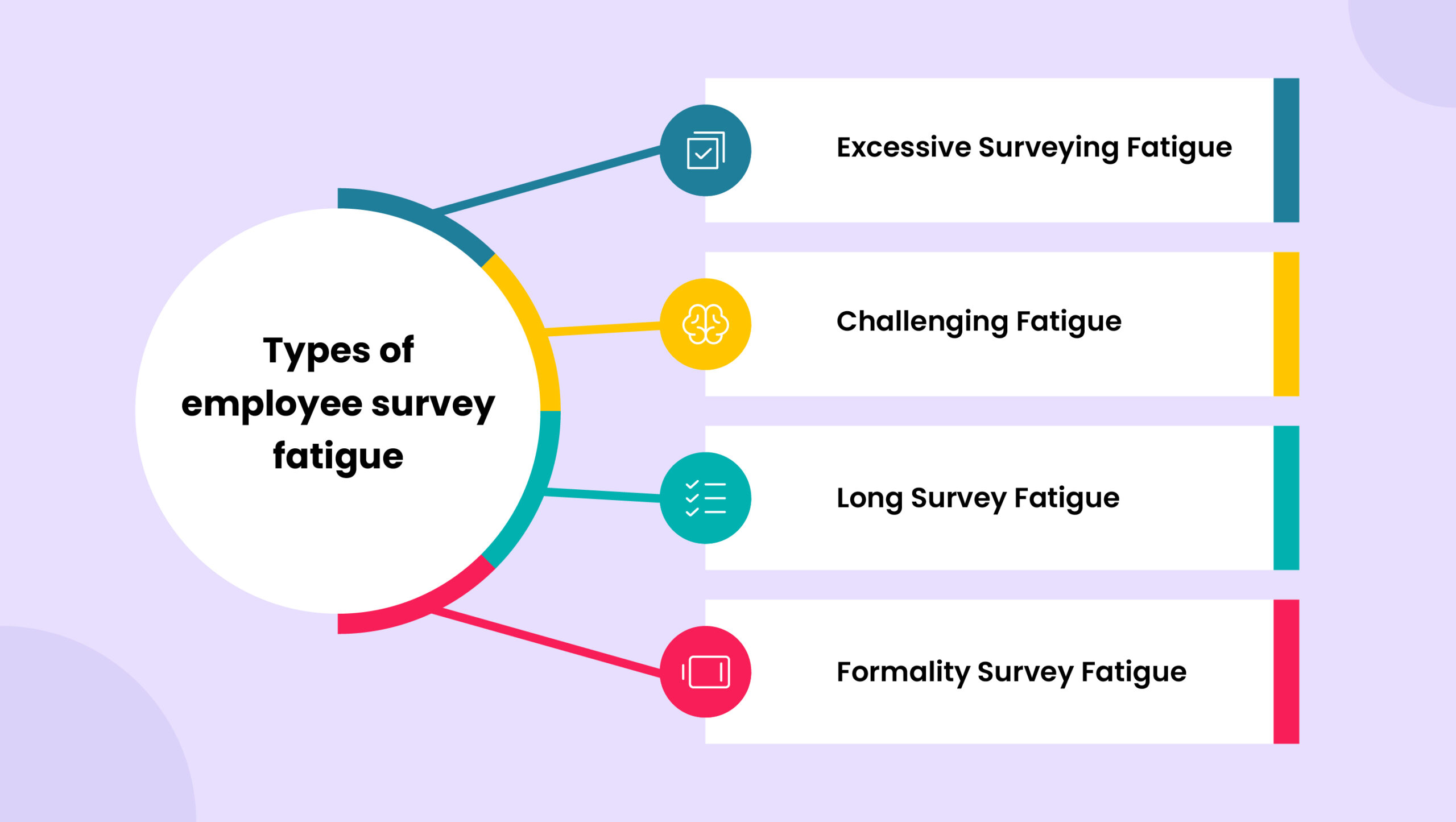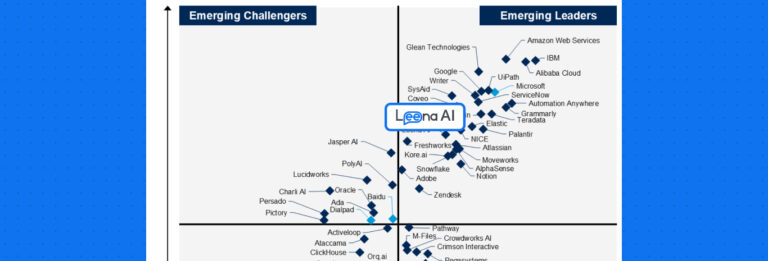With organizations introducing feedback surveys as the primary method of listening to their employees, survey fatigue is becoming a common concern. Conducting surveys is crucial to any organization that wishes to understand its employees better. Parallelly, feedback surveys offer employees a reliable platform to express their views freely. Then, what is causing employee survey fatigue?
Why are organizations observing a drop in their response rates over time? Why is the workforce losing interest in responding? How to increase employee survey participation?
Keep reading to find answers to these questions – understand in detail the main causes of survey fatigue, what are the types of survey fatigue, and how to avoid employee survey fatigue in your organization.
What is employee survey fatigue?
Employee survey fatigue refers to a point wherein you have asked your employees to complete surveys too often or too repeatedly, leading to a lack of motivation to participate in further surveys and even resulting in a drop in their participation rate.
It might not seem like a big problem to solve, but employee survey fatigue can result in:
- Losing insights into how employees feel about the organization and their work
- Drop in productivity and employee engagement levels
- Lack of accurate insights on employee engagement and overall experience
- Disengaged workforce leading to a gradual increase in employee attrition
- A toxic work culture
What are the types of employee survey fatigue?

Survey fatigue can act as the principal generator and diversify into varied types of fatigue that can further act as an aversion to meaningful employee feedback. Let’s understand in detail the types of employee survey fatigue and the best practices to avoid them from happening.
Excessive surveying fatigue
In this type of fatigue, employees are asked to respond to too many feedback surveys in a very short period of time. HRs could resolve this type of fatigue by establishing a survey frequency that will not lead to exhaustion. Excessive surveys force employees to rush through the questions and give feedback for the sake of completion.
Challenging fatigue
This type of employee survey fatigue occurs when surveys ask tedious and challenging questions that make the survey-taking process a negative experience for employees rather than an empathetic one. This can be resolved by having short and direct questions that are easy to answer and contextual to an employee.
Long survey fatigue
When employees are expected to set aside a significant amount of time to respond to surveys, they may experience this type of fatigue. It is best to add only the important questions related to one particular theme so that employees do not lose focus of the survey agenda.
Formality Survey Fatigue
This type of employee survey fatigue happens when employees fill out the surveys as part of the protocol and simply look at it as just another task they have to complete. To prevent this, HR personnel must work on the shortcomings of the previous surveys and highlight the actions taken to address employee issues. They also need to focus on making these surveys more personalized to an employee’s journey with the organization.
Now that you know the various types of employee survey fatigue, let’s look into how you can prevent it.
Tips to avoid employee survey fatigue
The presence of employee survey fatigue can hamper the quality of results obtained from a survey. Here are a few tips to help your HR team reduce employee survey fatigue:
Have a well-defined plan

When you are designing an employee engagement survey, make sure you have a well-orchestrated plan. Here are three things to consider:
Aim of the survey
You must have an idea of what you want to learn from your employees before you begin. It’s important that you have clear goals so that you can receive quality feedback and make the most of the data. It is critical to consider whether you want the survey to be based on a single theme or multiple themes?
Survey frequency
Try conducting quarterly surveys so that employees don’t experience boredom due to taking frequent surveys. If employees feel like they are being spammed by a never-ending stream of questions—they will not take the time to provide honest feedback.
Incorporate usage of pulse surveys

As discussed, poorly created long and confusing surveys can lead to poor employee engagement insights and further employee disengagement. Survey fatigue can lead to some severe issues like wrong employee feedback, poor quality data, low motivation, and unproductive time consumption. This leads to unstrategic or irrelevant actions from the management, which results in employees getting annoyed due to perceived apathy from management. The answer to avoiding all of these issues is pulse surveys.
Pulse surveys are quick surveys that focus on a specific area for improvement. They help in monitoring employee mental-wellbeing, understanding employee sentiments, and employee engagement levels. The key difference between a regular survey and a pulse survey is that pulse surveys are designed to gauge the pulse of the organization, which means they are shorter and more focused.
The best thing about pulse surveys is that it helps combat the 4 types of survey fatigue, producing reliable and consistent data points for the management to work on.
Acknowledge and act on the survey feedback

The first step to understanding a problem is to acknowledge its existence. Surveys are only useful when the data collected is meaningful and then acted upon.
Surveys are aimed at understanding employees’ concerns and pain points at the workplace. Needless to mention that ignoring these concerns will have a negative impact such as lowered employee morale, increased employee turnover, disengagement among the workforce, and more.
HRs need to identify and analyze the root cause behind the existing concerns of their employees. This can help in building data-based employee engagement and retention strategies which can further lead to preventing future employee turnover, a healthy work-culture and building high levels of productivity.
Follow a proper survey schedule

Repeated surveys can also lead to response fatigue and produce unreliable data. As a general rule, the frequency of surveys must be inversely proportional to the number of questions asked in each survey.
For example, a monthly survey should not have more than 15 questions and a bi-annual survey should not exceed 20-25 questions.Keeping surveys short would allow the stakeholders to gather relevant and updated information and work on issues as they come up.
It is also important that surveys are anchored to a specific schedule, It allows employees to anticipate them and be ready with the feedback. HRs do not need to dedicate an entire team to execute scheduled feedback surveys. Smart HR tools like Leena AI, can automate the entire process and take care of the timely circulation of surveys.
Customize and personalize the survey

There are several standardized questions available in the market that aim to gauge employee engagement. However, these questions do not apply to every company. So, it is important that you use a questionnaire that is customized according to your targeted department or employees in the organization. To further personalize these questions, you may share different surveys for different audiences.
The more you personalize your surveys, the better and more authentic the responses will be. But to be able to personalize and automate the surveys at scale, you will need to leverage AI-based HR tools. AI-powered survey platforms use machine learning to continually update and learn from employee feedback data and equip you with in-depth insights on employee engagement levels.
Get help from an expert partner to get started

The more your company grows, the more hectic it gets to gather data using engagement surveys. With a reliable partner like Leena AI, you can do more than just automate your surveys. You can collect and derive actionable insights from the feedback received on a single engagement survey platform. This makes it easier to collate employee feedback at scale and also identify sentiments driving them.
Some of the other features that make Leena AI the perfect partner to conduct impactful employee surveys include:
- Personalized surveys for all employees– from freshers to leadership
- Real-time data that you can act upon instantly
- Ability to track improvements and send follow-ups
- Sentiment analysis backed by natural language processing and machine learning
- Easy integration with HRMs and popular communication channels like, Teams, Whatsapp, Slack, etc.
Communicate the value of the employee engagement surveys

When it comes to conducting a survey, your questionnaire should be relatable and should not sound manipulative. It’s a good practice to make sure that whenever you’re asking people for their time there’s some acknowledgment on your part. It is important for employees to know that their feedback is valued and it acts as the primary source of change in the organization.
This way, your employees will take the surveys seriously and respond considerately. HRs need to communicate the results of the received feedback on a constant basis, and make the new-changes evident to employees by sharing follow-up feedback surveys.
Maintain anonymity in all surveys

Employees are wary of being honest in surveys since anonymity is a major issue. To collect accurate survey results and build trust, it’s imperative that employees feel free while responding to the questions. Unless that happens, people will not feel comfortable giving their sincere opinions, which eventually leads to employee survey fatigue. Give your employees the choice to share feedback, suggestions, comments, and remarks anonymously.
Keep it short and simple
Based on the employee engagement survey tool your company uses, the length and the time required to complete the survey will vary. While many tools offer over 100 questions in their employee survey templates, they may not always be impactful.
To get honest feedback from your employees and gain insights into their everyday issues, try to limit the questions you ask. Additionally, use simple language that doesn’t confuse the respondents or create ambiguity around the objective of the survey.
Make it interesting
To help fight employee survey fatigue, you should implement 360-degree feedback for each of your employees. This will make each employee feel involved in the feedback process, creating a new, exciting opportunity for them to give and receive feedback on their personal development opportunities. Such practice greatly benefits both parties and contributes to the overall engagement within the company.
“As an industry leader, it is time to adopt new leadership practices. If we want to retain and attract valuable talents, we need to create proactive solutions to achieve this. For instance, yearly employee reviews are irrelevant in today’s workplace. Employees want consistent feedback and communication. It gives them the chance to improve immediately and monitor their progress. Annual assessments do not motivate or engage employees as it fails to recognize or appreciate contributions and achievements. Improving employee engagement requires utilizing AI-powered technology and creating new leadership strategies.” – Samantha Moss, Editor & Content Ambassador, Romantific
Summing up
Employee feedback surveys are a great way to dive deep into the current mental state of your employees, but repeated surveys can lead to employee survey fatigue and might not provide relevant feedback data. Therefore, the frequency of surveys, the appropriate length, and a well-thought survey theme can help remarkably in getting meaningful insights.
A good way to reduce employee survey fatigue in the future is by employing AI-driven employee engagement solutions like Leena AI. You can discover real-time actionable insights by implementing interactive employee engagement surveys and automate the entire process right from building surveys, sending timely reminders, to feedback analysis and acknowledgement emails. Leena AI’s employee engagement solutions offer insights into the exact areas where you need to focus your efforts to increase employee performance.
Ready to eliminate employee survey fatigue? Book a demo today!
Get In TouchFrequently Asked Questions
How do you address survey fatigue?
The best way to do this is by planning and managing the frequency of the surveys being shared. Additionally, you should communicate the value of the survey to get insightful answers and reduce survey exhaustion. It will also help to keep the survey short so it doesn’t tire the respondents.
How do you motivate staff to complete a survey?
Again, communicating the value each survey holds will help employees to answer honestly. You can also set aside a specific time for employees to respond so that they do not forget to do it eventually. You may also hold direct managers responsible. This way, they will focus on keeping track of the survey process.
What is the maximum amount of time a survey should take to prevent survey fatigue?
On average, surveys should be between 3-5 minutes. And if it exceeds the 20-minute mark, your employees will most likely not uphold the quality of responses.
How long should an employee engagement survey be?
Ideally, an employee engagement survey should have between 15 to 20 questions or have as many as possible so that respondents can finish answering in under 15 minutes.






